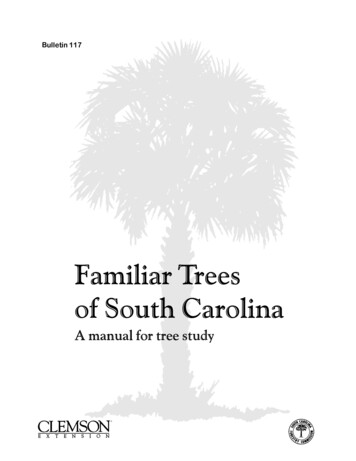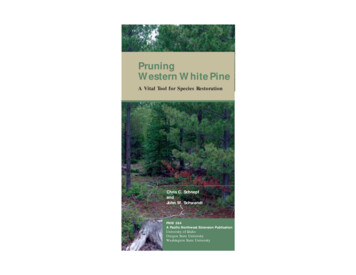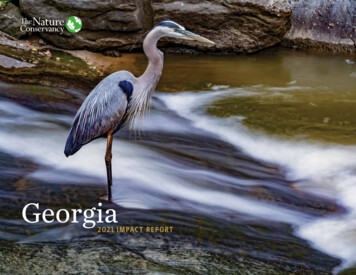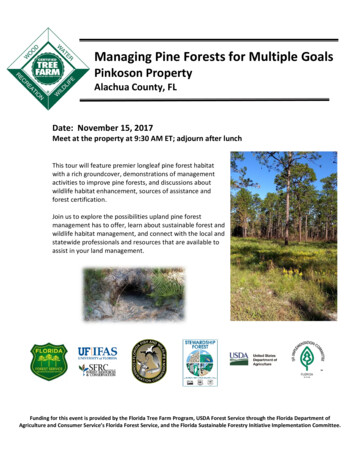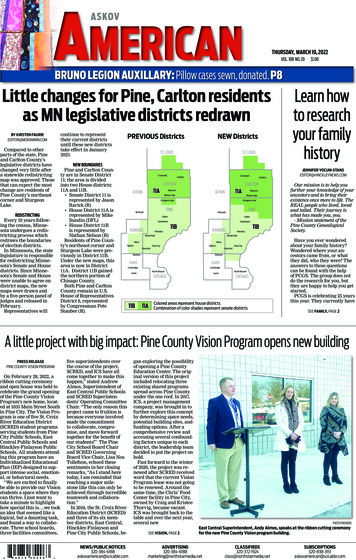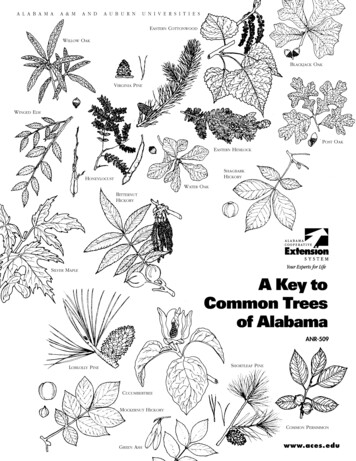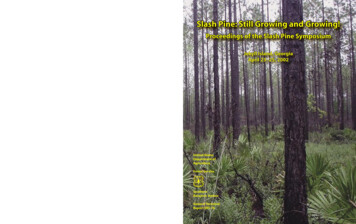
Transcription
The USDA prohibits discrimination in all its programs andactivities on the basis of race, color, national origin, sex, religion,political beliefs, sexual orientation, or marital or familial status(not all prohibited bases apply to all programs). Persons withdisabilities who require alternative means for communicationof program information (Braille, large print, audiotape, etc.)should contact the USDA’s TARGET Center at 202-720-2600(voice and TDD).Proceedings of the Slash Pine SymposiumJekyll Island, GeorgiaApril 23–25, 2002United StatesDepartment ofAgricultureForest ServiceSouthernResearch Station2004To file a complaint of discrimination, write USDA, Director,Office of Civil Rights, Room 326-W, Whitten Building, 1400Independence Avenue, SW, Washington, DC 20250-9410 or call202-720-5964 (voice and TDD). USDA is an equal opportunityemployer.Slash Pine: Still Growing and Growing! Proceedings of the Slash Pine SymposiumThe Forest Service, United States Department ofAgriculture (USDA), is dedicated to the principle ofmultiple use management of the Nation’s forestresources for sustained yields of wood, water,forage, wildlife, and recreation. Through forestryresearch, cooperation with the States and private forestowners, and management of the National Forests and NationalGrasslands, it strives—as directed by Congress—to provideincreasingly greater service to a growing Nation.Slash Pine: Still Growing and Growing!General TechnicalReport SRS-76
The use of trade or firm names in this publication is for reader information and does notimply endorsement of any product or service by the U.S. Department of Agriculture orother organizations represented here.PESTICIDE PRECAUTIONARY STATEMENTThis publication reports research involving pesticides. It does not contain recommendations for their use, nor does it imply that the uses discussed here have been registered.All uses of pesticides must be registered by appropriate State and/or Federal agenciesbefore they can be recommended.CAUTION: Pesticides can be injurious to humans, domestic animals, desirable plants,and fish or other wildlife if they are not handled or applied properly. Use all pesticidesselectively and carefully. Follow recommended practices for the disposal of surpluspesticides and their containers.
Slash Pine:Still Growing and Growing!Proceedings of the Slash Pine SymposiumJekyll Island, GeorgiaApril 23–25, 2002Edited byE.D. Dickens, J.P. Barnett, W.G. Hubbard, and E.J. JokelaHosted byFlorida and Georgia Divisions of the Southeastern Society of American ForestersThe University of Georgia, Warnell School of Forest ResourcesUniversity of Florida, School of Forest Resources and ConservationU.S. Department of Agriculture Forest Service, Southern Regional Extension ForestrySponsored byFlorida and Georgia Divisions of the Southeastern Society of American ForestersThe University of Georgia, Warnell School of Forest ResourcesUniversity of Florida, School of Forest Resources and ConservationThe Florida Division of ForestryThe Georgia Forestry CommissionThe Georgia Center of Continuing EducationU.S. Department of Agriculture Forest Service, Southern Regional Extension ForestryU.S. Department of Agriculture Forest Service, State and Private Forestry, Southern RegionPublished byU.S. Department of Agriculture Forest ServiceSouthern Research StationAsheville, North Carolina 28804December 2004i
PrefaceThis general technical report on slash pine is printed 20 years after an earlier proceedings, “The ManagedSlash Pine Ecosystem” was published. It was evident in 1983 that loblolly pine was becoming the speciesof choice where either species could be planted, especially in areas where fiber-volume production was ahigh priority. Since 1997–98, forest industry activities, pine pulpwood stumpage prices, timberlandownership patterns, and the economics of growing southern pines have dramatically changed in theSoutheastern United States. Many scientists and land managers are rethinking species/site selection, cashoutlays, and forest management intensities. The authors of this proceedings decided to share their newknowledge of slash pine.Slash pine continues to be an important species of southern yellow pine on the southeastern Coastal Plain.While its native range is more limited than any other southern yellow pine, its value as raw material forwood products ranks third behind loblolly and shortleaf pine. Although slash pine may not produce as muchwood volume or fiber on many of the sites where both loblolly and slash pine are found, it can producemore high-value, high-grade lumber than loblolly pine. Some of the papers in this proceedings eithercompare or include loblolly pine as a research subject, because these two species often are the onlychoice of pine species in the southeastern Coastal Plain.The authors’ intent is to give land managers an up-to-date guidebook on slash pine management. Althoughwe have learned much in the last 20 years, there is still much we have to learn. The 1983 managed slashpine ecosystem proceedings has some very valuable information that remains current to this day. Thereader should use his/her best judgment where conflicting opinions are presented; pine study findings maycontradict one another due to several abiotic, biotic, management, and other factors.The efforts of many people made the slash pine symposium possible. The following is a list of those whocontributed to planning; conference program organization; making local arrangements; lining up sponsorsand exhibits committees; and inviting symposium speakers, moderators, and reviewers.Planning Committee: Jill Barbour, John Bridges, Chris Carey, Steve Chapman, David Dickens, Mark Frye,George Hernandez, John Holzaepfel, Bill Hubbard, Eric Jokela, Susan King, Charlie Marcus, Mike Mengak,Jarek Nowak, and Larry ThompsonConference Chair: Bill HubbardProgram Co-Chairs: David Dickens and Eric JokelaSponsors and Exhibits Committee: John Bridges, Steve Chapman, and David DickensLocal Arrangements Committee: Chris Carey, Mark Frye, and Susan Kingii
ContentsPageSlash Pine: Characteristics, History, Status,and Trends . . . . . . . . . . . . . . . . . . . . . . . . . . . . . . . . . .James P. Barnett and Raymond M. SheffieldSlash Pine Tree Improvement . . . . . . . . . . . . . . . . . .Tim L. White and Tom D. ByramSlash Pine Establishment: What Has Changed—1981–2002? . . . . . . . . . . . . . . . . . . . . . . . . . . . . . . . . .Marshall JacobsonCompetition Control in Slash Pine(Pinus Elliottii Engelm.) Plantations . . . . . . . . . . . . .J.L. Yeiser and A.W. EzellNutrient Management of Southern Pines . . . . . . . . .Eric J. JokelaPlanting Density Impacts on Slash Pine StandGrowth, Yield, Product Class Distribution, andEconomics . . . . . . . . . . . . . . . . . . . . . . . . . . . . . . . . . .E. David Dickens and Rodney E. WillLoblolly Versus Slash Pine Growth and YieldComparisons . . . . . . . . . . . . . . . . . . . . . . . . . . . . . . . .Barry D. ShiverSpecies Deployment Strategies for the SouthernPines: Site Specific Management Practices for theFlatwoods of Georgia and Florida . . . . . . . . . . . . . . .Thomas R. FoxAn Economic Comparison of Slash and LoblollyPine under Various Levels of Management in theLower Atlantic and Gulf Coastal Plain . . . . . . . . . . .Coleman W. Dangerfield, Jr., E. David Dickens,and David J. Moorhead17PageWood Quality of Slash Pine and its Effect onLumber, Paper, and Other Products . . . . . . . . . . . . .Alexander Clark III and Richard F. Daniels20Prescribed Fire and Slash Pine . . . . . . . . . . . . . . . . .A.J. Long, A. Behm, L. Cassidy, J. DiMartino,D. Doran, D. Freeman, J. Helmers, K. Keefe, A. Miller,S. Ranasinghe, C. Randall, M. Rasser, A. Ruth,D. Shipley, and A. Van Loan23Wildlife Management Issues and Opportunitiesin Slash Pine Forests . . . . . . . . . . . . . . . . . . . . . . . . .Michael T. Mengak and Steven B. Castleberry27Insect Enemies of Slash Pine . . . . . . . . . . . . . . . . . .Terry S. PriceMajor Disease Issues with Slash PineManagement . . . . . . . . . . . . . . . . . . . . . . . . . . . . . . . .Robert. A. Schmidt61667984873645Effects of Annual Pinestraw Removal andMid-rotation Fertilization on Pine Growth inUnthinned Plantations . . . . . . . . . . . . . . . . . . . . . . . .E.A. Ogden and L.A. MorrisSlash Pine in Integrated Timber, Forage, andLivestock Silvopastoral Systems . . . . . . . . . . . . . . .Jarek Nowak and Alan Long909850Slash Pine, Pinus elliottii var. elliottiiSelect Bibliography . . . . . . . . . . . . . . . . . . . . . . . . . . 105Bryan C. McElvany, Kim D. Coder, andE. David Dickens56Index of Authors . . . . . . . . . . . . . . . . . . . . . . . . . . . . . 146iii
iv
SLASH PINE: CHARACTERISTICS, HISTORY, STATUS, AND TRENDSJames P. Barnett and Raymond M. Sheffield1Abstract—Slash pine is the premier tree species on many sites throughout the South. Its ease of establishment and earlygrowth, however, has extended its range to many sites where its performance has been less than ideal. For that reason, theacreage and volume of slash pine are declining. Nonetheless, it will continue to be the favored species on many sites where itis the most appropriate and productive species. This paper reviews slash pine’s important silvical characteristics, its historyof use and management, and the status and trends of this important resource.INTRODUCTIONTypical slash pine (Pinus elliottii Engelm. var. elliottii) is anexcellent timber tree and one of the most important pinespecies in the Southern United States. Many prefer it for itsfast growth and excellent utility for fiber, lumber, poles, andgum naval stores. The habitat and preferred sites within itsnatural range include poorly drained flatwoods and streamedges, as well as seasonally flooded areas such as baysand swamps.inches long in fascicles of two and three on the same tree.They are dark, glossy green, and tufted at the ends oftapering branches. They extend back some distance alongthe branch and persist until the end of the second season.Cones are 4 to 6 inches long, ovoid conic, and sessile(fig. 1). They usually remain on the tree until the secondsummer. Cones are reddish brown, lustrous, and armed witha sharp spine. The seeds are about one-fourth inch long,dark brown-black mottled, with thin, translucent wings about1 inch long.The ease and success of planting slash pine have significantly increased in its range. Extensive planting and naturalregeneration of open agricultural and forest land brought asharp rise in slash pine acreage between 1952 and 1970(Sheffield and others 1983). Much of the planting was onsites that did not favor slash pine, and where performancewas less than optimal. As a result, land managers haveplanted either loblolly (P. taeda L.) or longleaf (P. palustrisMill.) after harvesting the slash pine. However, slash pine isan excellent species and should be favored on appropriate sites.This paper reviews the important silvical characteristics ofslash pine; provides a history of its development, use, andmanagement; reviews its status in southern forest ecosystems; and explores trends in managed slash pine forests.SILVICAL CHARACTERISTICSIdentifying CharacteristicsThe typical slash pine tree has a long, clear bole and arelatively short crown, which results from self-pruning. SouthFlorida slash pine (P. elliottii var. densa) (Little and Dorman1954) differs from the more northern variety in a number ofways, primarily because its seedlings go through a dwarf“grass stage” similar to longleaf pine. Its stem divides intolarge, spreading branches that form a flat-topped orrounded crown. Its uniqueness and limited range haveencouraged neither research nor management of southFlorida slash pine.The needles and cones of the typical slash pine representits primary identifying characteristics. Needles are 7 to 10Figure 1—(A) mature, 2-year, closed cone (3 to 6 inches long);(B) mature cone open after shedding seed; (C) tips of cone scaleshowing variation in form of apophysis and stout prickle; (D) ventralside of cone scale with seed in place (left), and dorsal side (right);(E) and (F) seed and wing detached; (G) seed and wing intact (Mohr1896).1James P. Barnett, Chief Silviculturist; and Raymond M. Sheffield, Resource Analyst, U.S. Department of Agriculture Forest Service,Southern Research Station, Pineville, LA 71360 and Asheville, NC 28804, respectively.Citation for proceedings: Dickens, E.D.; Barnett, J.P.; Hubbard, W.G.; Jokela, E.J., eds. 2004. Slash pine: still growing and growing!Proceedings of the slash pine symposium. Gen. Tech. Rep. SRS-76. Asheville, NC: U.S. Department of Agriculture, Forest Service,Southern Research Station. 148 p.1
PhenologySeeds mature in a 3-year period from when the strobili areinitiated. The primordia of new strobili are detectable in latespring. These cone initials overwinter as buds the first year.When pollen is shed in late January or February of thesecond year, the male strobili are purple and 2 inches long.The female strobili appear on stalks in the upper crown andare about 1 inch long and red to purple at the time of pollination. Soon after pollination, the pollen tube stops growingand appears to remain in a quiescent state for the summerand winter. During the third growing season fertilizationoccurs—some 12 to 14 months after pollination. Conesenlarge and seeds mature during the third summer. Needlesdevelop on new growth in spring and persist until the end ofthe second growing season.DistributionThe natural range of slash pine is the most restricted of allmajor southern pines, extending from southern SouthCarolina to central Florida and westward to southeasternLouisiana (fig. 2). Although its natural range is relativelysmall, slash pine has been planted widely and its rangeextended into eastern Texas, southern North Carolina, andthe sandhills between the Coastal Plain and the Piedmontthrough much of the Southeast (Fisher 1983).Slash pine has been introduced into many countries fortimber production. Large-scale introductions have occurredin Brazil, Chile, Argentina, Venezuela, China, South Africa,New Zealand, and Australia. In most of these countries, it isan adequate seed producer, and natural or artificial regeneration continues.SOILS AND PHYSIOGRAPHYSoils within the range of slash pine are mostly Spodosols,Ultisols, and Entisols. It is generally believed that prior toextensive fire suppression and planting programs, slashpine was restricted to ponds, pond margins, and CoastalPlain flatwoods where ample moisture provided somedegree of protection for young trees that are often killed byFigure 2—The current distribution of slash pine.2fire (Gruschow 1952). Topography varies little throughout thesoutheastern Coastal Plain, but small changes in elevation often coincide with abrupt changes in soil and siteconditions.Although slash pine adapts to a wide variety of conditions, itgrows best on deep, well-aerated soils that supply amplemoisture during the growing season. Generally, growth andsite index increase with depth to a restrictive layer or seasonally high water table, if these features occur within 20 to30 inches of the soil surface. Where depth to a restrictivelayer exceeds about 30 inches, site index declines withincreasing depth to a reliable source of moisture, such as astable water table or a soil horizon with large moistureholding storage capacity. Soil properties useful in estimating site index of slash pine include depth to gray mottles,depth to a spodic horizon, depth to the least-permeablelayer or to a fine-textured horizon, thickness of the A1 horizon, and texture of the least-permeable or finest texturedhorizon (Lohrey and Kossuth 1990, Shoulders and Parham1983).SILVICULTURAL CHARACTERISTICSSlash pine is a subclimax species that without humanintervention and in the absence of fire or other catastrophicevent will proceed to a mixed hardwood forest. Someauthors consider it intermediate in tolerance to shade,others consider it intolerant. It will reproduce naturally insmall openings and invade poorly stocked longleaf pinestands, although competition from overstory and understory vegetation reduces growth and causes much mortality. The two varieties of slash pine differ in their patterns ofgrowth. Typical slash pine makes excellent early heightgrowth, but south Florida slash pine has a grasslike, almoststemless stage that lasts from 2 to 6 years. Moreover, southFlorida slash pine lacks the straight axis or stem characteristic of the typical variety and often develops forked boleswith large branches and an open, spreading, irregularlyshaped crown (Little and Dorman 1954).
Typical slash pine is slow to express dominance in dense,even-aged stands. As a result, height growth is slower invery dense stands than in moderately or lightly stockedstands. Young stands respond promptly to thinning orrelease.HISTORYThe development of steam-powered sawmills along thetidewater during the 1830s changed the entire complexionof timber use. Because the new mills required considerabletimber to maintain continuous operations, they were built atriver estuaries or along the banks of bayous. Slash pinestands were the most accessible and the first to be cut(Schultz 1983). However, it was not until post-Civil War timesthat more effective timber harvesting, transporting, andmilling technologies were developed. It was about 1880before more pines were cut for lumber than were beingdestroyed for the sake of clearing land (Vance 1935).Naval StoresIn colonial times, the great wooden ships of domestic andinternational commerce needed large quantities of pitch andtar to seal cracks—and to protect operating lines from thedeteriorating effects of moisture (Schultz 1983). By 1610,England was importing tree resin from the Colonies, and by1700 South Carolina had made so-called naval stores itschief export (Schorger and Betts 1915). Production of thiscommodity from the South’s piney woods became theState’s first full-scale industry.The primary method for producing naval stores was to tapstanding slash and longleaf pine. For many years the “box”method was used (Fernow 1899), whereby deep holes werecut with a boxing ax in the tree’s base and a container, orbox, was attached to catch resin, “chipping” was woundingthe tree surface or face with a hack tool—through the barkinto the phloem. The tree’s surface was chipped weekly tomaintain resin flow, and boxes were emptied every 2 or 3weeks to prevent resin loss. Because it produced more yieldthan longleaf, slash pine was preferred (Forbes 1930,Mattoon 1922).Naval stores research continued into the 1980s with thedevelopment of paraquat-induced lightwood (Stubbs 1983).However, production of naval stores products droppedsignificantly as tree availability decreased, costs of laborintensive work increased, and byproducts of the kraft pulping process met most of the need for turpentine and otherproducts (McReynolds 1983).The Influence of Railroad LoggingThe first generation of logging in pine flatwoods was confined to coastal areas and the immediate vicinity of riversand navigable streams. Therefore, much of the slash pineforest was selectively cut at least once by the late 1880s(Schutlz 1983). By the middle 1880s, high timber demandsand expanding mill facilities required loggers to exploit newareas. Railroad logging was an answer to the problem ofaccessing forests away from rivers and streams. Whereverlarge pines grew, rail spurs were put in to systematicallyremove pine timber. Low-speed locomotives were used topull cars loaded with timber over the temporary spurs.Steam skidders were mounted on flatcars, and wire cablescould pull logs to the railcars from about 1,000 feet.Logging and milling reached their peak in the coastal flatwoods between 1890 and 1914 (Schultz 1983). Once thelogging boom arrived, it took a little more than two decadesto clearcut and decimate the pure pine forests of the flatwoods. Most slash and mixed slash-longleaf pine forestswere cutover in the early logging and rafting days between1780 and 1860. Fifty to one hundred years later, theseareas had again grown into pure stands of slash pine andalso were logged over, as were virgin longleaf stands. Thecomplete removal of old-growth pines provided conditionsfor slash pine to further dominate many sites formerly occupied by longleaf pine. Large areas of the cutover longleafpine type in Alabama, Mississippi, Louisiana, and Texaswere planted to slash pine, thus increasing the range andprominence of the species (Schultz 1983). Slash pine alsowas planted outside its range in Georgia, South Carolina,and North Carolina in cutover longleaf sites.STATUSCutting deep cavities into trees for collecting gum causedsignificant damage to the trees. Cutting two or more boxesin larger trees nearly girdled them, causing mortality in ayear or so. Through the untiring efforts of Dr. Charles Herty,the “boxing” method was largely replaced by the cup-andgutter method around 1910. The new method yielded moreand higher quality resin, killed fewer trees, and left the buttlog in better condition for lumber (Croker 1979).When U.S. Department of Agriculture Forest Serviceresearch stations were established in the South in 1921, theSouthern Forest Experiment Station assigned Len Wymanto Stark, FL, to improve chipping technology for the navalstores industry. His work to reduce the size of the chippingface resulted in substantial labor savings, reduced treemortality, and increased the length of time a tree could beworked. During World War II, research on naval storesproduction was emphasized, and it was determined thatgum production could be stimulated by spraying the chippedarea with sulfuric acid (McReynolds 1983).The natural range of slash pine is more restricted than therange of other major southern pines (Critchfield and Little1966), but extensive plantings of slash pine have greatlyextended its range (fig. 2). We have not distinguished typical slash pine from the south Florida variety in these data,because the latter has very limited occurrence.While the range of slash pine is small, the species isintensely managed. Sixty-nine percent of current slash pinestands are planted compared to 52 percent in 1980. Theproportion of plantations to natural stands continues to risewith each new inventory.Slash pine is the primary species on 10.4 million acres(table 1). The slash pine ecosystem is defined as standswhere yellow pine makes up one-half or more of the stocking, and where slash is the predominant pine.The most concentrated areas of slash pine are in Floridaand Georgia. These two States contain about 79 percent ofthe slash pine ecosystem acreage.3
Table 1—Area of timberland classed as a slash pineforest type, by State, 1980 and North CarolinaSouth CarolinaTexasTotal19802000- - - - - thousand acres - - - 3618812,77910,375trees 5.0 inches diameter at breast height (d.b.h.) andlarger. The stated volumes exclude rough and rotten stems,stumps, tops, limbs, and trees 5.0 inches d.b.h.Seventy-two percent of the South’s slash pine volume(7,830 million cubic feet) is located in Florida and Georgia.Alabama, Louisiana, and Mississippi account for 22 percent (2,429 million cubic feet) (table 3).The diameter distribution of slash pine volume reflects thehigh proportion of slash pine in plantations and youngnatural stands (fig. 3). Volume peaks in the 8-inch diameterclass and declines rapidly through the larger diameters.Fifty-nine percent of the slash pine volume is in the 6-, 8-,and 10-inch diameter classes.The stand-age distribution shows that about 25 percent ofslash pine stands are 8 years old (fig. 4). This confirms thenotion that the slash pine rotation age is 30 years orNonindustrial private landowners hold 53 percent of slashpine stands, the largest proportion of ownership (table 2).Forest industries own 36 percent, while national forests andother public agencies control the remaining 11 percent.25Volume (percent)20The volume of slash pine growing-stock sized trees acrossthe range totals 10.9 billon cubic feet (table 3). This inventory includes all slash pine growing stock, whether in standsclassified as a slash pine type or in some other type. Growing-stock volume includes the solid wood content between a1-foot stump and 4.0-inch top on only the central stem inTable 2—Area of timberland classed as a slash pineforest type, by ownership class, 1980 and 910,375Table 3—Volume of slash pine growing stock ontimberland, by State, 1980 and 2000State19802000- - - - million cubic feet - - - AlabamaFloridaGeorgiaLouisianaMississippiNorth CarolinaSouth 022Diameter class (inches)2000- - - - - thousand acres - - - National forestOther publicForest industryNonindustrial private100Figure 3—Slash pine growing stock by diameter class, 2000.2.52.0Million (acres)Ownership class151.51.00.507 2 7 2 7 2 7 2 7 2 7 2 7 2 7 2 7 2 0 8 1 3 1 8 2 3 2 8 3 3 3 8 4 3 4 8 5 3 5 8 6 3 6 8 7 3 7 8 8 3 8 8 9 931 1 2 2 3 3 4 4 5 5 6 6 7 7 8 8Stand-age class (years)Figure 4—Stand-age distribution of slash pine, 2000.
younger, and that slash pine is intensively managed. Smalldiameter trees make up a large proportion of the slash pineresource, primarily because forest industry has managed itfor short rotations.Table 4—Net annual growth and removals of slash pinegrowing stock by State, 1980 and 2000StateThe current (2000) net annual growth of slash pine growingstock totals 871 million cubic feet (table 4). This is equivalent to a growth rate (growth as a percent of inventory) of 8.0percent. Annual removals of slash pine growing stock total927 million cubic feet, or 56 million cubic feet (about 6percent) over annual growth. The most significant amount ofremovals over growth occurs in Florida, where it exceededgrowth by 55 million cubic feet, or nearly 18 percent.Removal volumes include all slash pine trees removed fromcommercial forest land by human activities, regardless of whether the trees actually are h CarolinaSouth CarolinaTexasTotalNet annual growthAnnual removals1980200019802000- - - - - - - - million cubic feet - - - - - - - 25536431653541845231,068871675927TRENDSSheffield and others (1983) published 1980 resource data inthe proceedings of the 1981 managed slash pine ecosystem symposium (Stone 1983). These data, paired withyear 2000 data in tables 1 through 4, provide a comparisonof resource issues related to the slash pine ecosystem.The fact that 69 percent of slash pine stands are plantedindicates that the slash pine ecosystem is intensivelymanaged. Most of the ecosystem is located in Georgia andFlorida, and largely within areas adjoining the two States.However, over the last 20 years the area of timberlandclassified as slash pine has decreased from 12.8 to 10.4million acres, or nearly 19 percent (table 1).The loss of acreage in slash pine has occurred over most ofits range. Data from the two States that show increases—Louisiana and North Carolina—may not represent currentconditions, because forest survey data in those States havenot been completely updated. Within Florida the acreageremains stable, whereas in Georgia there has been a 35percent decrease over the last two decades.Long-term trends indicate that slash pine acreage increasedsignificantly during the 1950s and 1960s, with increasesfrom about 8.4 to 10.4 million acres (Sheffield and others1983). Those increases were related to the conversion offarmland to forests, reforestation of cutover forests, andplanting out of the native range of slash pine. The trendleveled off in the 1970s and 1980s. Obviously, the trend nowis one of decreasing acreage. This loss is at least partially aresult of longleaf pine restoration efforts on many siteswhere slash pine had been planted, the loss of slash pinesites to urbanization, and the planting of loblolly pine onforest industry lands where slash was previously planted.The greatest losses (about 20 percent) in slash pine timberland occurred on private ownership—both forest industryand nonindustrial private lands (table 2). Slash pine withinthe national forests decreased 5 percent, probably as aresult of conversion to longleaf pine on forests outside thenatural slash pine range. The only ownership showing anincrease in slash pine timberland is the “other public”category.The volume of slash pine growing stock in the entire ecosystem declined from 11.5 billion cubic feet in 1980 to 10.9billion cubic feet in 2000 (table 3). It is particularly interesting to note the differing trends in Florida and Georgia.Although Florida’s proportion of the growing stock increased12 percent, from 3.8 to 4.3 billion cubic feet, there was amajor decrease in Georgia. A 24-percent reduction ingrowing stock occurred in Georgia, with losses of 1.1 billioncubic feet. Texas and South Carolina were the only otherStates with losses of growing stock.The year 2000 distribution of slash pine growing stock bydiameter classes follows a pattern similar to that of 1980(Sheffield and others 1983), although 59 percent of thecurrent volume is in the 6-, 8-, and 10-inch classes compared to 64 percent in 1980 (fig. 3). In 2000, there was asmaller proportion in the 6-inch and a correspondingincrease in the 14- through 22-inch diameter classes thanthere was in 1980. Stand-age data confirm the notion thatolder stands continue to be aggressively harvested, andthat the average rotation age is 35 years or less (fig. 4).A relatively small proportion of stands are older than 40years.In contrast to the situation in 1980 when net annual growthexceeded annual removals, in year 2000 removalsexceeded growth by
The ease and success of planting slash pine have signifi-cantly increased in its range. Extensive planting and natural regeneration of open agricultural and forest land brought a sharp rise in slash pine acreage between 1952 and 1970 (Sheffield and others 1983). Much of the planting was on sites that did not favor slash pine, and where performance

